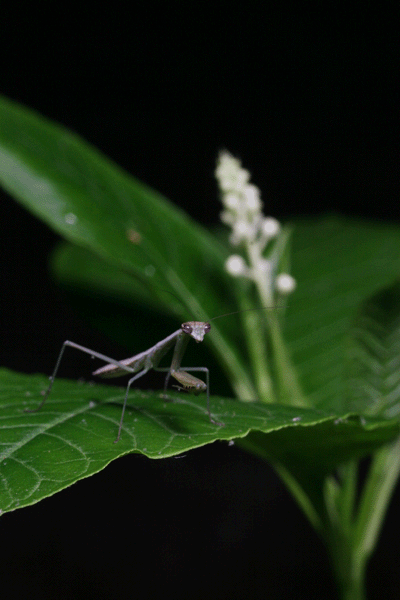Every once in a while someone remarks about how many frames I take, or why it might be necessary to take more than one of any given subject, or most especially, whether they should be doing this. It all depends on what one wants to get out of their photography, and what their end purposes are, but the answer is, “Yes.”
Took care of that one easily. Next post.
 Okay, sorry, let’s look at it in detail. First off, there’s always the possibility that autofocus wandered to the wrong point, or with moving subjects, you captured a frame where things simply didn’t look optimum. Then, there’s the idea that subtle changes in position (especially in macro work) can produce subtle but notable changes in the framing and background. Also to be considered are things like minor differences in lighting, perhaps from changing the strobe angle, or maybe because the clouds are shifting or the shadows are being thrown differently across your subject by waving branches. And then there’s the simple possibility that what you originally envisioned doesn’t illustrate your idea as well as you liked. Let’s take a look at a few images I shot last night to see what I mean.
Okay, sorry, let’s look at it in detail. First off, there’s always the possibility that autofocus wandered to the wrong point, or with moving subjects, you captured a frame where things simply didn’t look optimum. Then, there’s the idea that subtle changes in position (especially in macro work) can produce subtle but notable changes in the framing and background. Also to be considered are things like minor differences in lighting, perhaps from changing the strobe angle, or maybe because the clouds are shifting or the shadows are being thrown differently across your subject by waving branches. And then there’s the simple possibility that what you originally envisioned doesn’t illustrate your idea as well as you liked. Let’s take a look at a few images I shot last night to see what I mean.
This newly-budding cherry tomato, still retaining the flower petals that provoked its development, appears pretty much exactly as I wanted it to, even capturing a faint sheen of dew across the surface. The light angle is not quite direct (see highlights on leaf, and shadows to right,) but shows everything well and produces no shadows that hide the detail I wanted to display. Yet, the first frame I took was slightly out of focus, because this is a tiny subject and I cannot stand absolutely still, so I swayed ever-so-slightly out of position as I tripped the shutter – with high magnification, this can be movement as insignificant as a millimeter or less. Even looking at the camera’s LCD as I went along wasn’t enough to tell me that the focus wasn’t bang on. But then we come to the possibility that the image isn’t even illustrating the idea that I had as well as it could have. This is much more crucial when you might be working to someone else’s ideas, such as shooting for a publication of some kind. In many cases this can be demanding, because an editor may not want the black background, or needs a horizontal format, or something that gives a better impression of scale or stages of development.
 So then you might take a few different approaches, notably if you have options available to you. While I wasn’t going to get a better background last night, there being nothing close enough nor tall enough (this plant is actually over my head) to fill in for that darkness, I could have shot the same scene in daylight conditions to change the whole appearance. You might have noticed that the light angle changed by reversing the strobe, and that the one tomato from the previous image is now almost hidden away down in the corner, receiving a much less useful light angle and position in the frame. Yet, the context is more complete, a better sense of scale has (possibly, anyway) been produced, and more stages of tomato development are displayed in one image. Also, rather than being a mere illustration, a more artistic air has been produced, slightly more dynamic – some people might even find this a worthwhile art print (yeah, there’s no accounting for taste.)
So then you might take a few different approaches, notably if you have options available to you. While I wasn’t going to get a better background last night, there being nothing close enough nor tall enough (this plant is actually over my head) to fill in for that darkness, I could have shot the same scene in daylight conditions to change the whole appearance. You might have noticed that the light angle changed by reversing the strobe, and that the one tomato from the previous image is now almost hidden away down in the corner, receiving a much less useful light angle and position in the frame. Yet, the context is more complete, a better sense of scale has (possibly, anyway) been produced, and more stages of tomato development are displayed in one image. Also, rather than being a mere illustration, a more artistic air has been produced, slightly more dynamic – some people might even find this a worthwhile art print (yeah, there’s no accounting for taste.)
One thing that I missed is how some of the petals are cut off slightly by the frame edges. This is the entire image frame, so I screwed up slightly; I could have shot a little wider and had open space all around, and even shooting a bit wider than that would have given me options to crop as needed. This is something I often tell my students: shoot a bit wider than necessary (in other words, from farther away, or with the subject a little smaller in the frame if that helps.) You can always crop tighter if the image calls for it, but adding in the extra space is a lot of Photoshop work that you don’t want to do. Also, this can help in getting ‘routine size’ prints done, especially for portraits and weddings and so on. The standard image frame for most cameras is a 2×3 ratio, which translates to, for instance, 8×12 inches. But finding a place that routinely prints at 8×12 inches can be difficult, and finding a wood or metal frame to display the prints harder still – the standard yet remains 8×10 inches, which would cut off a significant portion of the long aspect. This image, for instance, just couldn’t be cropped down to that effectively – luckily, I can choose my aspect ratio for the blog without worrying about standards (but you already knew about my lack of standards.)
 Now let’s take a look at how subtle changes in position work. This mantis was perched on a pokeweed plant, and I purposefully positioned myself to capture the budding flowers in the background as a framing element. Take a look at how the flowers offset the mantis, and how much of the underlying leaf is shown, and even how the antenna appears in the frame. I didn’t even change the lighting, nor shoot any horizontal formats for this, but still have a variety of appearances to choose from. Chances are there’s one you like better than the others, and it might not be the one that I like. While most of the blog and site reflect my own preferences, if you’re looking to sell your images, it’s better if you meet with your client’s preferences instead, and this might mean several different options. These are very subtle changes compared to what could have been done easily, but they illustrate how much of a difference such subtle changes produce.
Now let’s take a look at how subtle changes in position work. This mantis was perched on a pokeweed plant, and I purposefully positioned myself to capture the budding flowers in the background as a framing element. Take a look at how the flowers offset the mantis, and how much of the underlying leaf is shown, and even how the antenna appears in the frame. I didn’t even change the lighting, nor shoot any horizontal formats for this, but still have a variety of appearances to choose from. Chances are there’s one you like better than the others, and it might not be the one that I like. While most of the blog and site reflect my own preferences, if you’re looking to sell your images, it’s better if you meet with your client’s preferences instead, and this might mean several different options. These are very subtle changes compared to what could have been done easily, but they illustrate how much of a difference such subtle changes produce.
When using film, this could mean firing off half a roll or more on one subject, not counting the frames that were misses and simply discarded – but one sale offsets that easily. With digital of course, this becomes far less of an issue, or so it seems – the primary difference is storage space on hard drives (yes, plural – you are maintaining routine backups, right?) However, the upfront cost of digital bodies has to be factored in too, especially if the photographer is one who feels obligated to keep chasing every new upgrade that comes along – pointlessly, in my opinion. And the truth is, people often hose around the frames with digital, secure in the knowledge that “it doesn’t cost anything.” There’s nothing terribly wrong with this, though to excess it shortens the life of the camera body, but it may end up working better if you’re selective about making the image right the first time rather than counting on ‘the odds’ to produce a right one from a batch. With fleeting subjects, this increases your chances of having a useful image before the subject changes or vanishes.
So, yes, this means there’s a balance point, which is true for most of photography, and you’ll have to find that which works best for you. While you have to gauge your habits to your intended usage, my primary advice, is, take enough frames to get the shot you want, and most especially, to make the sale you’re after. And, ‘too many’ remains better than, ‘not enough.’



















































